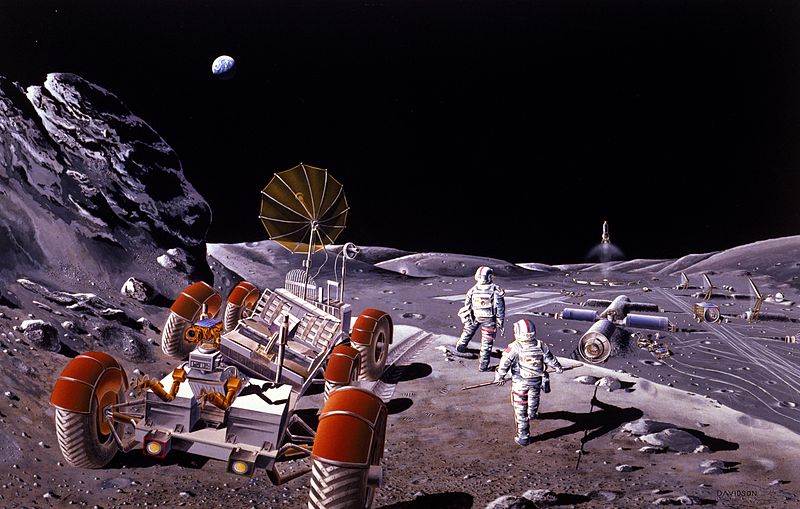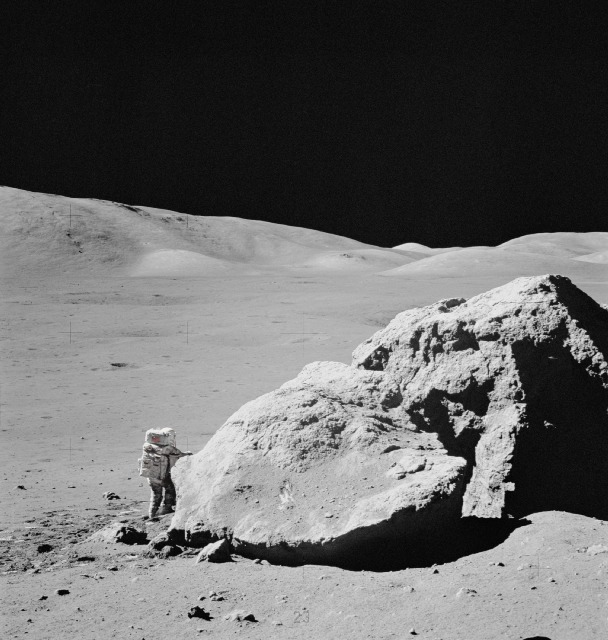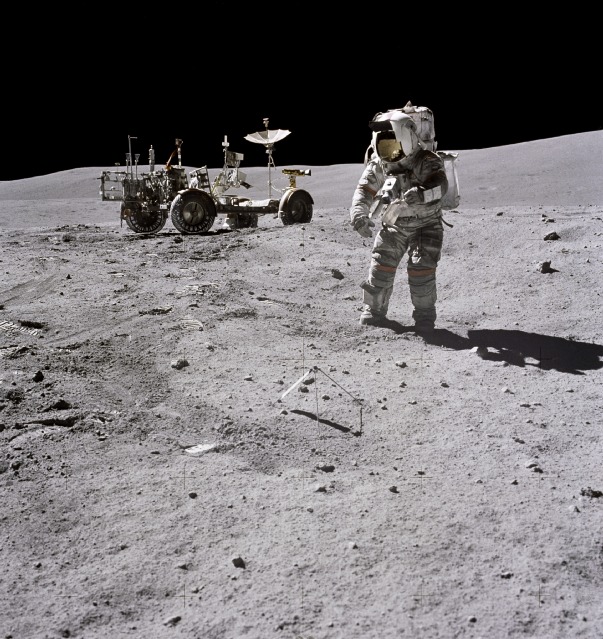
As the world counts down to next year’s maiden voyage of the Space Launch System (SLS) super-heavylift booster, carrying an uncrewed Orion spacecraft around the Moon on the Artemis-1 mission, NASA officials gathered for a media teleconference Monday afternoon (21 September) to discuss the current state of play as America aims to plant boots on the lunar surface for the first time since December 1972.
NASA Administrator Jim Bridenstine stressed the acute urgency of securing the requisite $3.2 billion in funding for the Human Landing System (HLS) into 2021 in order to meet the challenging 2024 goal, as well as reaffirming the agency’s desire to target the next lunar explorers at the South Pole, where an “Artemis Base Camp” will be sustainably assembled. However, Mr. Bridenstine refused to be drawn on a timeline for when an “Artemis Cadre” of astronauts will be announced and who they might be.
Yesterday’s media teleconference—whose participants also included Kathy Lueders, James Reuter and Thomas Zurbuchen, associate administrators for the Human Exploration and Operations Mission Directorate (HEOMD), the Space Technology Mission Directorate (STMD) and the Science Mission Directorate (SMD), respectively—came on the heels of NASA’s long-awaited release of its “Artemis Plan” to land the first woman and the next man on the Moon, four years hence.

In a comparatively short document, entitled “NASA’s Plan for Sustained Lunar Exploration and Development”, the agency outlined its drive to achieve the month-long Artemis-1 next year, a crewed circumlunar flight—not dissimilar to Apollo 8—in 2023, a piloted Moon landing at the South Pole in 2024 and the “first sustainable presence on and around” our closest celestial neighbor by the decade’s end.

Mr. Bridenstine kicked off proceedings by pointing to the astonishing pace with which Artemis has covered ground in recent months. He noted the “number of contracts already in place” to achieve the landing, with April’s announcement of three potential HLS providers perhaps the most visible example, and drew attention to the modernization of launch facilities at the Kennedy Space Center (KSC) in Florida and the impending Hot Fire Test of the four RS-25 engines of the first SLS core stage, which may occur in the late October or early November timeframe.

Several past attempts have been made to return humans to the Moon, notably the Space Exploration Initiative (SEI) under President George H.W. Bush in the early 1990s and the Vision for Space Exploration (VSE) by President George W. Bush at the dawn of the present century. But Mr. Bridenstine explained that these efforts came to nought principally because of intense political opposition, spiraling costs and long-running programs which elevated the risk of early cancelation.

The Artemis Program, on the other hand, has gotten down to business rapidly and work contracts are already underway through embedded partnerships between NASA and the private sector. This has led in particular to the full funding of an HLS for the first time since 1972.

The administrator indicated that strong bipartisan support exists for Artemis from both sides of the House, pointing out that it was “vitally important” for the HLS to receive its requisite $3.2 billion funding in 2021 for the landing on the Moon in 2024 to be realized.
Mr. Bridenstine hopes that the funding will be in place “by Christmas” and that a delay until March “becomes more difficult” to achieve the 2024 landing, but still “in the realm of possibility”. However, a delay beyond March would render it “increasingly more difficult”, although Mr. Bridenstine remained steadfast that NASA’s goal was to return humans to the lunar surface.

And where on the lunar surface has come to the fore in recent weeks, with some commentators taking the administrator’s previous statements to indicate that the complexity of reaching the lunar South Pole might be abandoned in favor of revisiting an equatorial Apollo site.
With undisguised humor in his voice, Mr. Bridenstine reflected that the comment originated in a recent Lunar Exploration Analysis Group (LEAG) meeting, during which the option of landing at an Apollo “heritage site” was considered.

Whilst such a return would be “kinda cool”, he stressed that NASA has “no plans” for Artemis to venture anywhere other than the South Pole. Already, the Volatiles Investigating Polar Exploration Rover (VIPER) was contracted earlier this year by the Commercial Lunar Payload Services (CLPS) to Astrobotic Technology, Inc. to land at the South Pole in 2023.
Dr. Zurbuchen echoed Mr. Bridenstine’s words by underlining that VIPER will be “so critical” in scouting out and characterizing the presence of water-ice to support a future Artemis Base Camp.

Judging from the reality that International Space Station (ISS) crews are typically named up to two years before launch, the assignment of a “cadre” of astronauts for Artemis-specific training cannot be far off. Mr. Bridenstine “would like to announce an Artemis cadre earlier rather than later”, feeling that it will provide “a source of inspiration”, although no plans for an announcement exist at this time.
Nor does a precise scientific agenda yet exist for what the Artemis-3 crew—expected to be the first human lunar landing since Apollo 17—and its successors will actually do on the surface. Primary focuses will include the identification of water-ice and understanding how to separate it from lunar regolith, although the administrator noted that “we haven’t made a final determination” for the scientific scope of the mission. He did point out, though, that the Moon provides “an extremely stable platform” for astronomical observations.
In her comments, Ms. Lueders provided some insights into progress so far, stressing that all three HLS contract teams—SpaceX, Dynetics and the Blue Origin National Team—have “been hitting every single milestone” in the five months since their announcement.
She explained that the SLS core stage for Artemis-1, “the last piece of the crew transportation system”, will soon be making its way to the Cape, and that Artemis-1 itself, “over a month long”, will include no fewer than 17 payloads, of which five originate from international partnerships. Artemis-2, a crewed Apollo 8-type circumlunar voyage in 2023, will run for ten days and is tasked with “making sure that all the critical systems are working”, before Artemis-3 flies in 2024.

Ms. Lueders expects to make the final HLS down-select award early next spring, citing the February-March timeframe. She pointed out that final proposals from SpaceX, Dynetics and the Blue Origin National Team are in the process of being formulated and felt that having a redundancy capability—not dissimilar, in a sense, to the dual provision of Commercial Crew partners in the form of SpaceX and Boeing—“is advantageous”. However, she said that nothing is formulated yet for having prime and backup HLS providers for the first and second Artemis landings in 2024 and 2025.
In “NASA’s Plan for Sustained Lunar Exploration and Development”, the agency notes that returning to the Moon “will mark a transformative moment for human civilization” and promises to be “the greatest feat of engineering and the greatest voyage of exploration and discovery in human history”.
It will be the first opportunity for most people alive today to witness a human lunar landing. And this immense endeavor hinges upon what NASA calls “Artemis Base Camp” to pave the way “for long-term economic and scientific activity at the Moon, as well as the first human mission to Mars in the 2030s”.
Following the Artemis-3 landing four years from now, NASA hopes to develop “a sustained, strategic presence” at the Moon’s South Pole. “Artemis Base Camp will be our first sustainable foothold on the lunar frontier,” read the report. “We will initially move to one- to two-month stays to learn more about the Moon and the Universe. We will develop new technologies that advance our national industries and discover new resources that will help grow our economy.”

Principal elements for the Base Camp, according to the report, are a Foundation Surface Habitat to enable short stays by up to four astronauts at the South Pole, a pre-positioned unpressurized rover called the Lunar Terrain Vehicle for shorter trips near the landing site and a pressurized rover known as the Habitable Mobility Platform for long-duration exploration. “Combined with supporting infrastructure added over time, such as communications, power, radiation shielding, a landing pad, waste disposal and storage planning,” NASA noted, “these elements comprise a sustained capability on the Moon that can be revisited and built upon over the coming decades.”
The astronauts’ “robust mobility systems” are acutely necessary in light of “the immense scale of the lunar geography”, the report continues. It is also expected, as Mr. Bridenstine outlined yesterday, that eventual “Mars analog” missions will be performed, with astronauts spending several months aboard the lunar-orbiting Gateway, followed by an extended period of exploration on the surface by part of the crew, then several more months back on the Gateway, to simulate the outbound and return journeys to and from the Red Planet.

Although no durations of these Mars analog missions have been revealed, NASA expects them to be “by far the longest-duration human deep-space missions in history” and will serve a critical need to operationally test the readiness of systems to go to Mars.
“The sequence as currently envisioned begins by sending lunar precursor robotic missions, including VIPER by CLPS landers to provide ground-truth of terrain, as well as water and metal resource availability for the human lunar landing site,” the report reveals. “To provide mobility and extended range of exploration for the first several human lunar surface missions, the LTV will be delivered to the lunar surface. He first elements of the Lunar Gateway are in development and will support later sustainable human lunar landing missions.
“The habitable mobility platform will be delivered to the lunar surface to expand our exploration range by tens of kilometers and mission duration on the surface from seven days to 30-45 days, enabling potential Mars surface analog missions on the lunar surface,” the report continued.
“Other key pieces of the Artemis Base Camp infrastructure are also delivered, including the Foundation Surface Habitat, which will support a crew up to four on the lunar surface, the lunar surface power systems, In-Situ Resource Utilization (ISRU) demonstrations and pilot plants. An evolved Gateway habitation capability in lunar orbit will allow us to begin the methodical lengthening of mission durations.

“This approach will also allow NASA to test risk mitigation approaches for long-duration mission crew and element systems risks that are required for two-year Mars-class missions,” NASA added. “Once these pieces of the Moon to Mars campaign are delivered and operational, annual human missions with increasingly long durations will enhance the exploration and sustainable development of the lunar surface.”
FOLLOW AmericaSpace on Facebook and Twitter!
Missions » SLS » Artemis »





Maybe, if they don’t have to report any sum of money they spend, they would have already achieved a goal of return to the Moon.